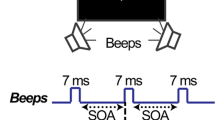Abstract
Music practice is a multisensory training that is of great interest to neuroscientists because of its implications for neural plasticity. Music-related modulation of sensory systems has been observed in neuroimaging data, and has been supported by results in behavioral tasks. Some studies have shown that musicians react faster than non-musicians to visual, tactile and auditory stimuli. Behavioral enhancement in more complex tasks has received considerably less attention in musicians. This study aims to investigate unisensory and multisensory discrimination capabilities in musicians. More specifically, the goal of this study is to examine auditory, tactile and auditory-tactile discrimination in musicians. The literature suggesting better auditory and auditory-tactile discrimination in musicians is scarce, and no study to date has examined pure tactile discrimination capabilities in musicians. A two-alternative forced-choice frequency discrimination task was used in this experiment. The task was inspired by musical production, and participants were asked to identify whether a frequency was the same as or different than a standard stimulus of 160 Hz in three conditions: auditory only, auditory-tactile only and tactile only. Three waveforms were used to replicate the variability of pitch that can be found in music. Stimuli were presented through headphones for auditory stimulation and a glove with haptic audio exciters for tactile stimulation. Results suggest that musicians have lower discrimination thresholds than non-musicians for auditory-only and auditory-tactile conditions for all waveforms. The results also revealed that musicians have lower discrimination thresholds than non-musicians in the tactile condition for sine and square waveforms. Taken together, these results support the hypothesis that musical training can lead to better unisensory tactile discrimination which is in itself a new and major finding.


Similar content being viewed by others
References
Anatürk M, Jentzsch I (2015) The effects of musical training on movement pre-programming and re-programming abilities: an event-related potential investigation. Biol Psychol 106:39–49
Audacity Team (2019) Audacity(R): free audio editor and recorder [Computer application]. Version 2.3.1. https://audacityteam.org/. Retrieved 20 Mar 2019
Chang X, Wang P, Zhang Q, Feng X, Zhang C, Zhou P (2014) The effect of music training on unimanual and bimanual responses. Musicae Scientiae 18(4):464–472
Cohen JD (1993) PsyScope: a new graphic interactive environment for designing psychology experiments. Behav Res Methods Instrum Comput 25(2):257–271
Elbert T, Pantev C, Wienbruch C, Rockstroh B, Taub E (1995) Increased cortical representation of the fingers of the left hand in string players. Science 270(5234):305–307
Gaser C, Schlaug G (2003) Brain structures differ between musicians and non-musicians. J Neurosci 23(27):9240–9245
Gescheider GA (2013) Psychophysics: the fundamentals. Psychology Press, London
Gruhn W (2002) Phases and stages in early music learning. A longitudinal study on the development of young children’s musical potential. Music Educ Res 4(1):51–71
Habib M, Besson M (2009) What do music training and musical experience teach us about brain plasticity? Music Percept Interdiscip J 26(3):279–285
Herholz SC, Zatorre RJ (2012) Musical training as a framework for brain plasticity: behavior, function, and structure. Neuron 76(3):486–502
Kishon-Rabin L, Amir O, Vexler Y, Zaltz Y (2001) Pitch discrimination: are professional musicians better than non-musicians? J Basic Clin Physiol Pharmacol 12(2):125–144
Kraus N, Chandrasekaran B (2010) Music training for the development of auditory skills. Nat Rev Neurosci 11(8):599
Landry SP, Champoux F (2017) Musicians react faster and are better multisensory integrators. Brain Cognit 111:156–162
Landry SP, Guillemot JP, Champoux F (2013) Temporary deafness can impair multisensory integration: a study of cochlear-implant users. Psychol Sci 24(7):1260–1268
Landry SP, Guillemot JP, Champoux F (2014) Audiotactile interaction can change over time in cochlear implant users. Front Hum Neurosci 8:316
Micheyl C, Delhommeau K, Perrot X, Oxenham AJ (2006) Influence of musical and psychoacoustical training on pitch discrimination. Hear Res 219(1–2):36–47
Münte TF, Altenmüller E, Jäncke L (2002) The musician’s brain as a model of neuroplasticity. Nat Rev Neurosci 3(6):473
Pantev C, Oostenveld R, Engelien A, Ross B, Roberts LE, Hoke M (1998) Increased auditory cortical representation in musicians. Nature 392(6678):811
Raab DH (1962) Division of psychology: statistical facilitation of simple reaction times. Trans NY Acad Sci 24(5):574–590
Rouger J, Lagleyre S, Fraysse B, Deneve S, Deguine O, Barone P (2007) Evidence that cochlear-implanted deaf patients are better multisensory integrators. Proc Natl Acad Sci 104(17):7295–7300
Simpson WA (1988) The method of constant stimuli is efficient. Percept Psychophys 44(5):433–436
Spiegel MF, Watson CS (1984) Performance on frequency-discrimination tasks by musicians and nonmusicians. J Acoust Soc Am 76(6):1690–1695
Strait DL, Kraus N, Parbery-Clark A, Ashley R (2010) Musical experience shapes top-down auditory mechanisms: evidence from masking and auditory attention performance. Hear Res 261(1–2):22–29
Tervaniemi M, Just V, Koelsch S, Widmann A, Schröger E (2005) Pitch discrimination accuracy in musicians vs nonmusicians: an event-related potential and behavioral study. Exp Brain Res 161(1):1–10
Young GW, Murphy D, Weeter J (2017) Haptics in music: the effects of vibrotactile stimulus in low frequency auditory difference detection tasks. IEEE Trans Haptics 10(1):135–139
Funding
Funding was provided by Natural Sciences and Engineering Research Council of Canada (RGPIN-2016-05211).
Author information
Authors and Affiliations
Corresponding author
Additional information
Publisher's Note
Springer Nature remains neutral with regard to jurisdictional claims in published maps and institutional affiliations.
Rights and permissions
About this article
Cite this article
Sharp, A., Houde, M.S., Maheu, M. et al. Improved tactile frequency discrimination in musicians. Exp Brain Res 237, 1575–1580 (2019). https://doi.org/10.1007/s00221-019-05532-z
Received:
Accepted:
Published:
Issue Date:
DOI: https://doi.org/10.1007/s00221-019-05532-z




